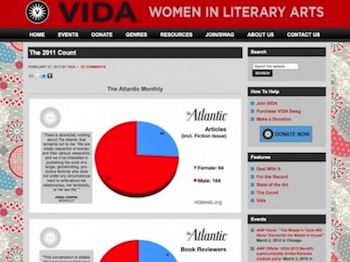Fuse News: Gender Underrepresentation in the Media — VIDA Surveys Dudesville and Beyond
VIDA, an association of women in the literary arts, has released its fifth annual tally of the number of women critics in major literary publications as well as the number of works by women being reviewed. The numbers are getting better – notably better in some places – but they’re still not good.
By Clea Simon
Paint a landscape. Anything you want. Only, you can’t use green. Or, let’s be fair, you can, but only a smidge – say no more than a nickel-sized dollop on your palette. And not, you know, too green. OK, then? Go wild.
Picturing a desert? You’re in luck. Same with, say, a high mountain scene or maybe a particularly stormy night. And if you prefer to work in black and white, as many of the greats do, then this prohibition won’t bother you in the least. Your viewers, who presumably know your style, will have no cause for complaint. The rest of them? They can go look elsewhere.
Unless they can’t. And that, in a nutshell, is the problem with gender underrepresentation in the media. Yes, it’s that time of year again and yes, VIDA, an association of women in the literary arts, has released its fifth annual tally of the number of women critics in major literary publications as well as the number of works by women being reviewed. And while the numbers are getting better – notably better in some places – they’re still not good.
As a woman author, I can tell you this sucks. (Though, in all fairness, I am almost equally up in arms about genre as well as gender discrimination – because, you know, traditional mysteries are not as important as slash’em up thrillers. Though, come to think of it, trad mysteries – “cozies” – are usually written by women, while thrillers are still overwhelmingly penned by men, hmmm…) But really this isn’t simply a women’s issue. It’s a reader issue. Because if people of any type are looking for guidance on what to read next and they are not hearing from a representative population, then they are not seeing the full spectrum of what is out there. Yes, they can look for themselves – but as bookstores stock newspaper-list bestsellers or (at best) “heard on NPR” shelves, and radio and magazine features focus on the same – these review sections function as gatekeepers. To readers, and thus to aspiring writers, critics, authors.
As I’ve said, it sucks. How bad is it? A quick look at the charts tells the story. Although this year’s count has expanded to include some cool journals – the VIDA Larger Literary Landscape – the mainstream media is still undeniably slanted. The New York Review of Books, for example, still has 212 male critics and only 52 women. You think that might be why 307 of the works reviewed were by male authors, while only 80 were by women? Ditto Harpers, with its 24 male critics to 10 female – reviewing 49 books by men, and 19 by women. Other members of “Dudeville,” as VIDA puts it, include The Atlantic, London Review of Books, New Republic, The Nation, and The New Yorker. “Drumroll for the 75%ers,” says VIDA. Would that it announced the coming of a tumbrel.
There is some good news. The New York Times Book Review and The Paris Review have both gotten better. The Paris Review went from 70 male bylines and 18 female in 2012 to 47 and 48 in 2013. The Times has added critics – and added more women than men: last year the paper had 400 male reviewers and 327 female. This year, it had 412 male and 393 female. Counting numbers of critics, bylines, and books reviewed brings the Times up to a full “VIDA Count” of 894 male, 725 female, and 1 transgender. (VIDA is aware of the issues surrounding binary classifications of gender but not at this point prepared to address them, says an editor’s note, for fear of “mission drift.” Not that others can’t take up these and further battles.)
Here in Boston, things are marginally better than the literary world at large. The Boston Review has equity in reviewers this year (10 of each), but not in authors reviewed (22 male authors to 10 female). Counting number of bylines and also micro-reviews, that comes to an overall count of 143 male to 106 female. The New England Review has an overall count of 53 male to 35 female. The Boston Globe isn’t in the count, but it does have a woman editing the book reviews (which helps). Plus, they let me write for them (as well as such better known names as Caroline Leavitt and Katherine Powers). So, yeah, maybe there is hope. But count in the backlash – Jennifer Weiner, anyone? – and you know that we’re not close to an endgame yet.
We will be. The VIDA count is part of it. So is getting angry. Read the report. Spread the word.
A former journalist, Clea Simon is the author of three nonfiction books and 14 mysteries. A contributor to such publications as the Boston Globe, New York Times, and San Francisco Chronicle, she lives in Somerville with her husband, Jon Garelick. She can be reached here and on Twitter @Clea_Simon.


I would (sadly) expect the unfairness anywhere else.
But The Nation?
Yup. Did you look at the VIDA charts, Shelley? Kind of shocking.